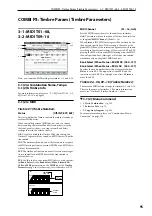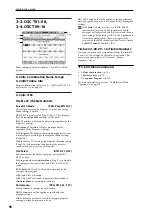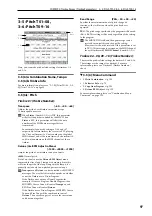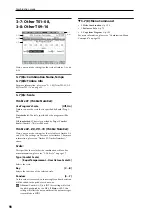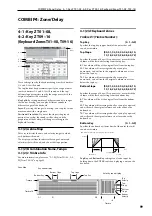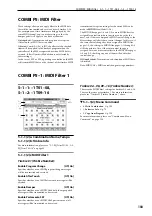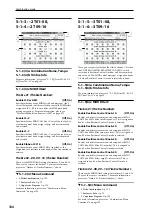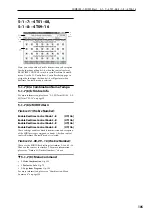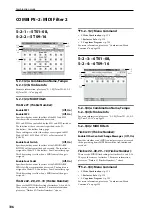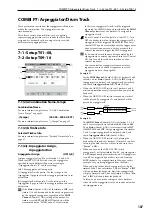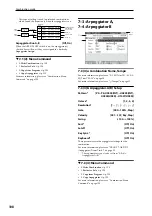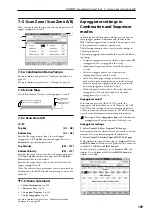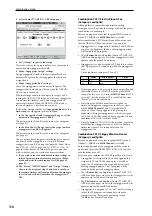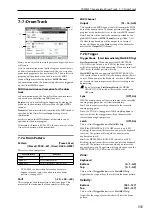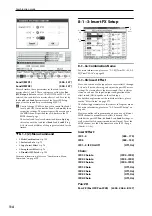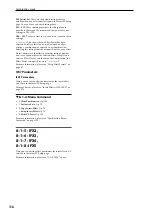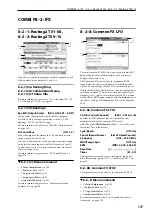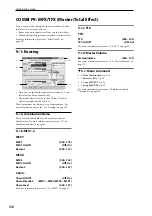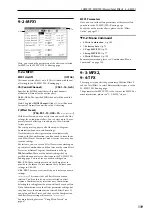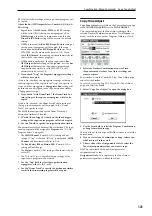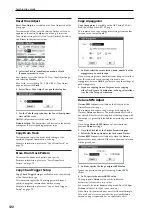
COMBI P7: Arpeggiator/Drum Track 7–1: Setup T01–08, 7–2: Setup T09–16
107
COMBI P7: Arpeggiator/Drum Track
These parameters specify how the arpeggiator will function
within the combination. Two arpeggiators can run
simultaneously.
This offers a variety of possibilities, such as applying
separate arpeggio patterns to two sounds that have been
assigned as a keyboard split, or using velocity to switch
between two arpeggio patterns.
7–1: Setup T01–08,
7–2: Setup T09–16
7–1(2)a: Combination Name, Tempo
Combination Name
For more information, please see “2–1(2)a: Combination
Name, Tempo” on page 93.
(Tempo)
[040.00...300.00, EXT]
For more information, please see “
7–1(2)b: Timbre Info
Selected Timbre Info
For more information, please see “Selected Timbre Info” on
page 81.
7–1(2)c: Arpeggiator Assign,
Arpeggiator Run
Arpeggiator Assign
[Off, A, B]
Assigns arpeggiator A or B to each timbre 1–8 and 9–16.
When the ARP ON/OFF switch is on, the arpeggiator
specified for each timbre will operate according to
“Arpeggiator Run A, B” and these settings.
Off:
The arpeggiator will not operate.
A:
Arpeggiator A will operate. Use the settings in the
Arpeggiator A page to select the arpeggio pattern and to set
parameters.
B:
Arpeggiator B will operate. Use the settings in the
Arpeggiator B page to select the arpeggio pattern and to set
parameters.
If the
Status
(Combi 3–1(2)c) of the timbre is
INT
, each
timbre 1–16 will be sounded by the note data generated
by the assigned arpeggiator, regardless of the
MIDI
Channel
(Combi 3–1(2)c) setting of the timbre. If a
timbre is set to
EXT
or
EX2
, MIDI note data will be
transmitted on the “MIDI Channel” of that timbre.
In this case, arpeggiator A (or B) will be triggered
(operated) by all MIDI channels specified for the
MIDI
Channel
parameter of any timbre 1–16 assigned to
arpeggiator A or B.
If Local Control (Local Control On, Global P1: 1–1a) is
OFF, the keyboard will not trigger the arpeggiator.The
arpeggiator will be triggered via MIDI IN. Turn Local
Control OFF if you have recorded only the trigger notes
on an external sequencer, and wish to playback the
external sequencer to trigger the M50’s arpeggiator.
If you want to record the note data generated by the
arpeggiator to an external sequencer, turn Local Control
ON, and turn off the echo back function on your
external sequencer.
You can control the arpeggiator from an external
sequencer, or use an external sequencer to record
arpeggio note data. (See page 400)
Example 1)
Set the
MIDI Channel
(Combi 3–1(2)c) of timbres 1 and 2
to
Gch
, and set
Status
(Combi 3–1(2)c) to
INT
. Assign
arpeggiator A to timbre 1 and arpeggiator B to timbre 2,
and check
Arpeggiator Run A, B
(Combi 0–5(6)a).
• When the ARP ON/OFF switch is off, timbres 1 and 2
will sound simultaneously (layered) when you play the
keyboard.
• When the ARP ON/OFF switch is turned on, timbre 1
will be played by arpeggiator A, and timbre 2 will be
played by arpeggiator B.
Example 2)
The
MIDI Channel
(Combi 3–1(2)c) of timbres 1, 2, 3, 4,
and 5 are set respectively to
Gch
,
Gch
,
02
,
Gch
, and
03
.
Their
Status
(Combi 3–1(2)c) is set respectively to
INT
,
Off
,
INT
,
Off
, and
INT
. Assign arpeggiator A to timbres
2 and 3, assign arpeggiator B to timbres 4 and 5, and
check
Arpeggiator Run A, B
(Combi 0–5(6)a).
• When the ARP ON/OFF switch is off, playing the
keyboard will sound only timbre 1. (Timbres 2 and 4 are
receiving the
Gch
, but they will not sound since their
“
Status
” is
Off
.)
• When you turn on the ARP ON/OFF switch,
arpeggiator A will play timbres 2 and 3, and arpeggiator
B will independently play timbres 4 and 5. (Arpeggiators
A and B are triggered by note data received from any
MIDI channel of an assigned timbre. However, in this
example, they are being triggered from the
Gch
.)
When you play the keyboard, arpeggiator A will play
timbres 2 and 3, but only timbre 3, whose “
Status
” is
INT
will sound from the keyboard. Similarly, arpeggiator B
will play timbres 4 and 5, but only timbre 5, whose “
Sta-
tus
” is
INT
will sound from the keyboard.
In this way, you can make settings so that a timbre is
silent when the arpeggiator is off, and sounds only when
the arpeggiator is on.
7–1a
7–1
Menu
7–1b
7–1c
Timbre 1
MIDI Ch=Gch Status=INT
Timbre 2
MIDI Ch=Gch Status=INT
Arpeggiator
A
Arpeggiator
B
Arpeggiator
Assign
A
B
Pattern - A
Pattern - B
Pattern - A
Pattern - B
Trigger
= Gch
Trigger
= Gch
Summary of Contents for M50-73
Page 1: ...2 E Parameter Guide ...
Page 86: ...Program mode 78 ...
Page 132: ...Combination mode 124 ...
Page 222: ...Sequencer mode 214 ...
Page 297: ...Effect Mixer Block Diagrams Main Outputs 289 ...
Page 418: ...Appendices 410 ...



